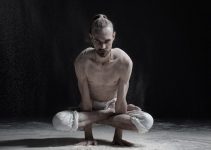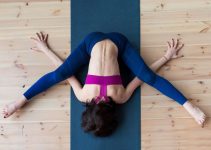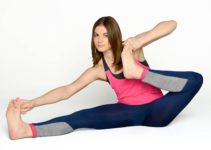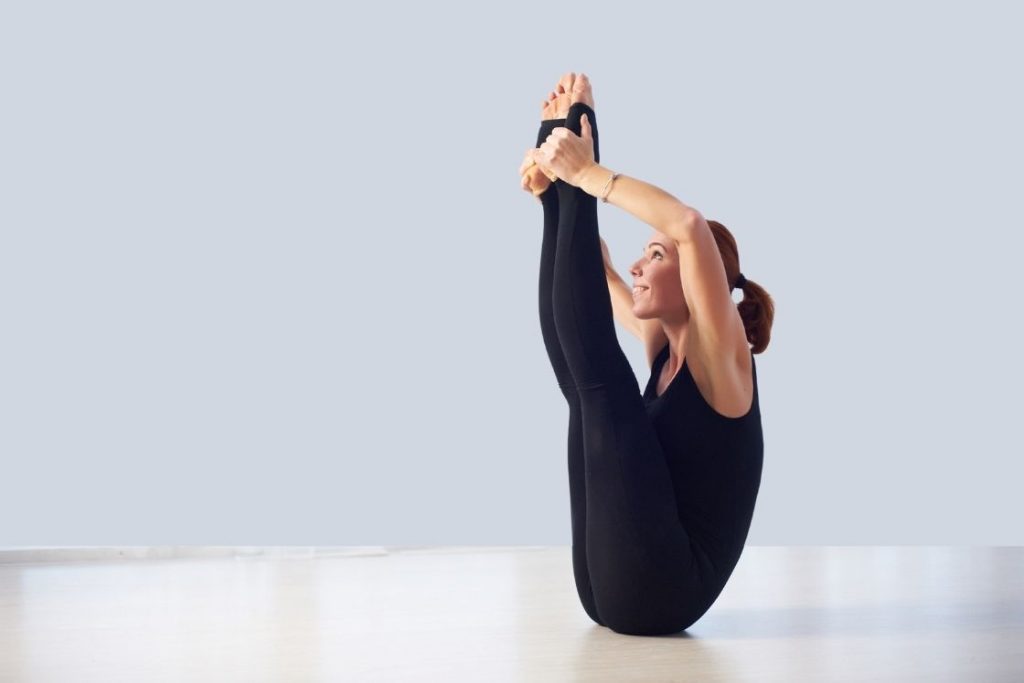
Urdhva Mukha Paschimottanasana is a fusion of paschimottanasana and ubhaya padangusthasana (both big toe pose). It is one of the important poses of the primary sequence of the Ashtanga vinyasa yoga series.
This is an advanced level posture due to the involvement of intense posterior stretch. Besides stretching, it involves forward bending and requires strength and balance to maintain the pose.
While holding this pose the body is balanced on the sit bones. The legs are stretched straight overhead held by the hands.
This upward intense leg stretching posture also focuses on strengthening the back, core, and pelvis muscles. It also elongates the spine and calms the nervous system.
Meaning
Urdhva Mukha Paschimottanasana is a composite word, having the following root terms derived from Sanskrit..
- Urdhva means upward or raised
- Mukha refers to the face
- Paschimo means back of the body (west)
- Uttana denotes intense stretch
- Asana means pose.
The name itself summarizes the posture where the practitioner stretches the back and legs up intensely raising the face to look up.
Also, known by its English translation as Upward facing intense west stretch or upward-facing intense stretch pose.
Urdhva Mukha Paschimottanasana Practice Guide
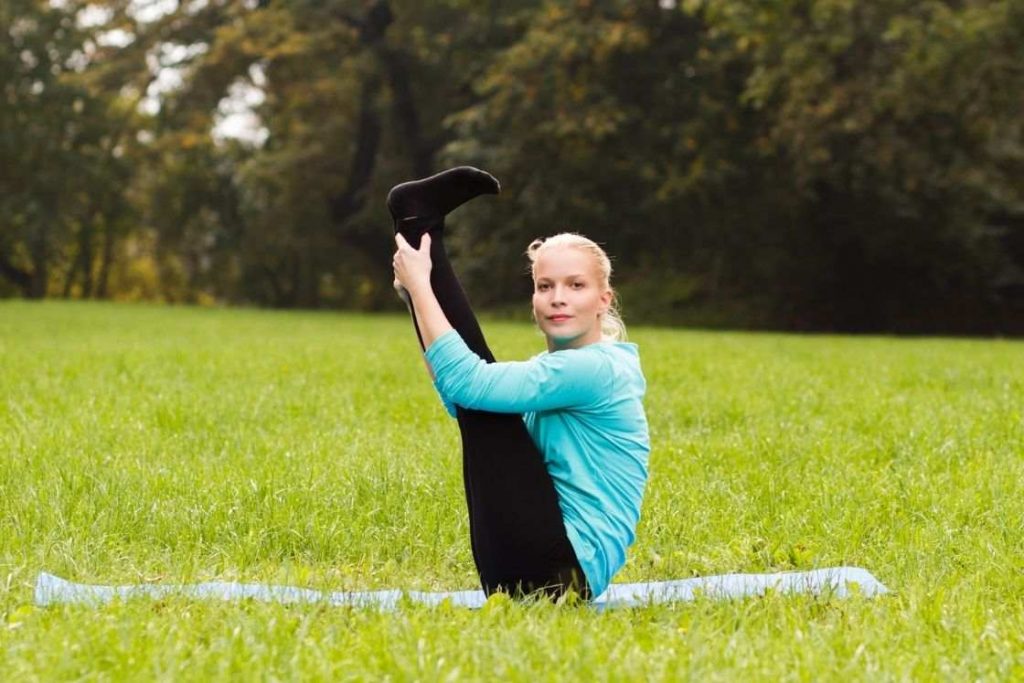
To perform this intense leg stretching posture work on gaining lower body strength and flexibility. Gaining expertise in paschimottanasana and ubhaya padangusthasana will come in handy.
Besides this, keep the following preparatory tips in mind before stepping into the pose.
Precautions & Contraindications
- Avoid the pose with injury in the lower back, hips, hamstring, knees, pelvis, or core muscles.
- Do not perform urdhva padangusthasana while recovering from any internal surgery.
- Skip this pose during pregnancy or menses.
- An elderly individual must take aid using props to perform the asana.
- Avoid it if you are suffering from hemorrhoids, diarrhea, or Irritable bowel syndrome (IBS).
- People with abnormal blood pressure must refrain from this pose.
- Migraine patients must avoid this practice.
- Do not practice this pose in case of hernia or fibromyalgia.
Preparatory Poses
- Boat Pose (Navasana)
- Head-to-Knee Forward Bend (Janu Sirsasana)
- Seated Forward Bend (Paschimottanasana)
- Standing Forward Bend (Uttanasana)
How to Do Urdhva Mukha Paschimottanasana (Steps)
- Begin with sitting in dandasana and gently lie down on your back.
- Inhale, raising your arms overhead.
- Straighten your legs and lifting your hips bring your feet to your hands. Grab your soles using your palms.
- Inhale straightening your back.
- Exhale and roll up on your back to balance the body on the sit bones.
- Find your balance at this point, inhale and look upwards.
- Exhale, moving the lower abdomen forward bring the torso closer to the legs.
- Bring your forehead to your knees then rest your chin to knees gazing upwards.
- Maintain the pose for five breaths.
- Inhale leaning slightly away from the legs still maintaining the gaze up.
- Exhale release the hands and bend the legs to reach the floor.
- Take a deep breath in and relax in the initial position.
Follow-up Poses
Modifications
- Using Wall – This modification is mostly recommended for senior citizens. Here the wall is used to take support while holding the pose in an upward direction. The feet or legs can be lifted off the ground and kept adjacent to the wall.
- Yoga Ropes – Tie two ropes and form a noose with each of them. Hang them over both sides of the head. As you lie on your back raise the arms to hold on to the noose. After this, bring the feet overhead curl up pulling the ropes. This adds external support to perform the pose easily.
Variations
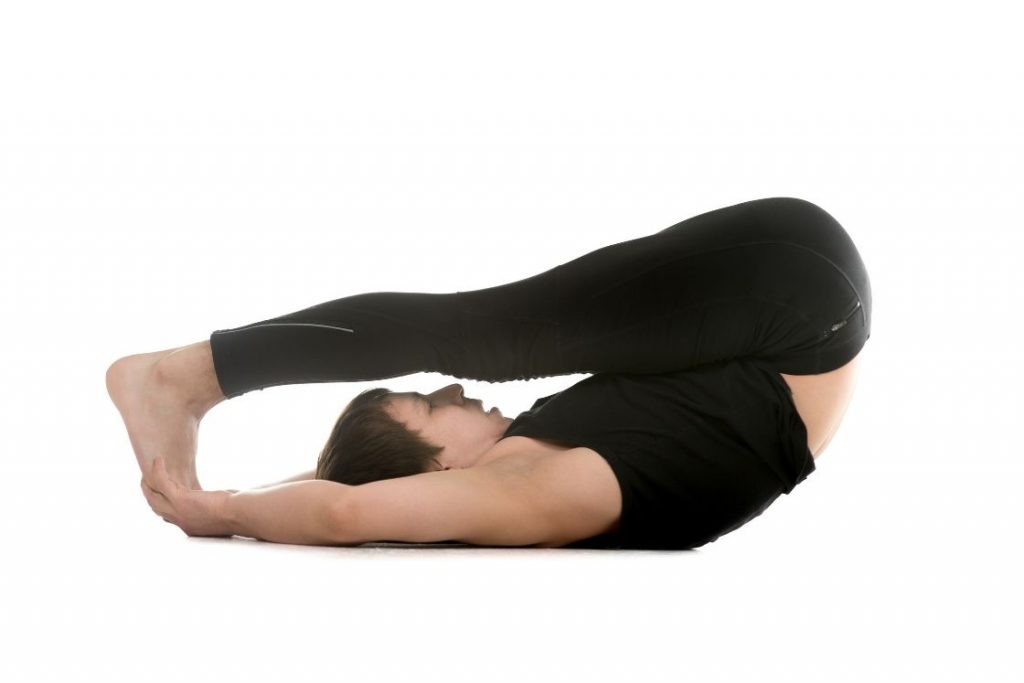
- Urdhva mukha paschimottanasana II – This is the supine variation of Urdhva mukha paschimottanasana where the chin rests on the knees. This method is described in Iyengar’s Light on Yoga plate 170.
Lie on your back straightening the legs and raising the arms overhead. Lift the legs off the floor clasping the hands around the soles. Stretch the legs bringing them to the floor overhead by widening the elbows. It’s also called supta paschimottanasana.

- Urdhva mukha paschimottanasana leg variation- It is performed after attaining the final posture on Urdhva mukha paschimottanasana.
Keeping the chin on the left knee, bend your right knee pointing the toes forward. The lower leg is kept perpendicular to the thigh. Keep the hands on the soles. Repeat it to another leg.
Therapeutic Applications
- Urdhva mukha paschimottanasana brings calmness to the brain by enhancing the blood flow to the nerves. Thus beneficial in relieving stress and anxiety.
- This pose is very recommended to prevent hernia.
- Urdhva mukha paschimottanasana also alleviates the lower back pain.
- It is also a powerful leg and back stretching pose that can rectify the postural defects. It also used to get shapely calves.
Urdhva Mukha Paschimottanasana Benefits
1. Strengthens the leg muscles
Urdhva mukha paschimottanasana works intensely on leg muscles. It stretches the hamstrings, calves, and ankles. This increases the blood flow to these muscles and eventually makes them stronger.
2. Enhances spine flexibility
The integrity of the spine is maintained throughout the pose. This is followed by rhythmic breathing that directs the pranic flow towards the back and elongates the spine. This improves the elasticity and strength of the spine.
3. Tones the arms
Urdhva mukha paschimottanasana stretches the entire body. As the arms are also stretched while holding the pose, it exercises the shoulder, arms, wrist, muscles. It brings an increased amount of blood and oxygen to the muscles and the stretch involved helps in toning them.
4. Burns extra fat
This intense stretch acts as a full-body workout. It contracts the muscles of the abdomen, thighs, and buttocks thereby shedding extra fat from these regions. Therefore it is also beneficial to maintain the ideal body weight.
5. Improves digestion
While holding the pose the anatomical organs like the stomach and intestines experience extreme pressure. Other internal organs like the kidney, liver, spleen, etc. also get stimulated.
It enhances the efficiency of the digestive system and thus helps in improving digestion.
6. Maintains the reproductive system
The pelvic region is also stretched while holding the pose. It stimulates the reproductive organs and enhances the blood flow towards this region. Therefore the reproductive organs are exercised and activated.
7. Stimulates the endocrine system
In urdhva mukha paschimottanasna, the neck muscles are stretched. It stimulates the thyroid gland present at the base of the neck. It helps in the secretion of the thyroid hormone. Hence, the endocrine system is also benefitted and regulates metabolism.
8. Activates the sacral chakra
Due to the stretching of the lower abdominal muscles, the sacral chakra is also stimulated. The activation of this energy chakra helps in maintaining better relationships, brings joy, and elevates creativity.
